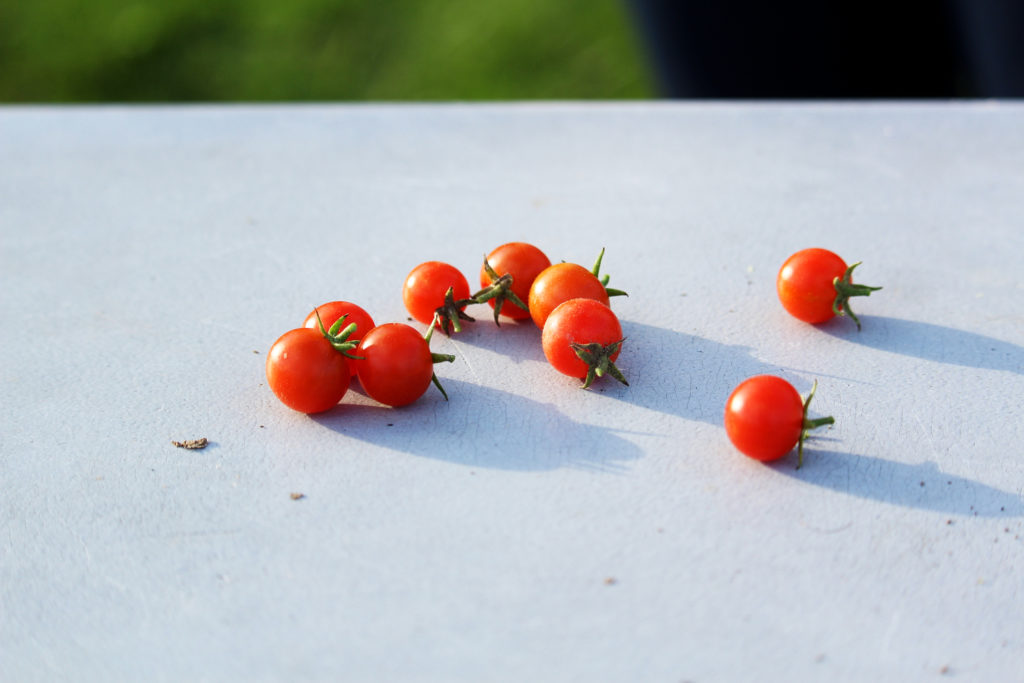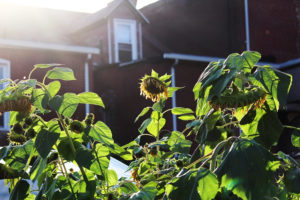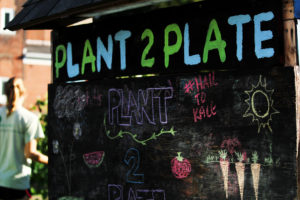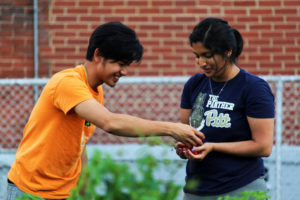Cultivating Lives, One Plate at a Time

words: Lauren Zawatski
photos: Lauren Zawatski
Are those collard greens?” a man asks. “Can I have some?”
A quick “Sure!” from Leanna Travis makes the man smile. Travis is a senior neuroscience major at the University of Pittsburgh and head of the urban garden on Oakland Avenue and Sennott Street. The garden, full of plants and herbs, helps feed people such as Carmen, the elderly man seeking produce who lives just a few feet away.
Created and maintained by Pitt’s student organization Plant to Plate, the garden serves as a community of its own within Oakland, specifically for Pitt students.
“Over the years, it’s changed, but our goal now is to make this place a space for Pitt students to learn about growing their own food, local food and produce in general,” Travis says.

Afternoon light spills over a neighboring house, illuminating Plant to Plate’s sunflower patch.
The space is its own little world. It sticks out like a sore (green) thumb in the middle of the dark, tall city buildings and housing spaces it’s surrounded by. Some people walk by, oblivious to the oasis growing right next to them. But for those inside the greenery, it’s become more than just a garden; it’s a place of community.
“My favorite part is to interact with different people,” Travis says.
The garden is a place where people who may never have even walked by each other on Pitt’s 35,000-student campus get to meet and work side by side. Various Pitt student organizations like Gamma Sigma Sigma, Alpha Phi Omega, the Nursing Student Association and more are among those that volunteer regularly. Some people who volunteer don’t know everyone within their own club, so when they come to the garden, they have an opportunity to get acquainted and also meet people from different clubs.
Clusters of people from different student groups often congregate around the rectangular picnic table at one corner of the garden. Introductions flow like rainwater onto the flourishing plants.
“Hi, I’m Megan, how are you?” one girl says.

Gabrielle Mueller works on a gardening fence in the garden.
It is obvious how much of the garden thrives because of community. Those who volunteer usually hear about it through other people. Rebecca Laher, for instance, got involved because of Travis, her roommate. The neuroscience student has many fond memories from the garden, including the time when she helped build the shed that now houses the garden’s many tools and supplies.
“That was a lot of fun,” she says. “We were trying to read the instructions but they were old and ripped apart. We were just looking at the pieces like ‘How do we do this?’”
Laher says that the moment the shed was completed was an exciting one.
“When we finally finished and put the roof on, everyone was jumping around and signed their initials on the door,” she says.
In addition to fostering community, the garden also provides a space for students to step back from the daily grind and relax. Joanna Moore, a nursing student who frequently volunteers at the garden, finds that it gives her a chance to breathe.
“It’s an opportunity to make myself go outside and get fresh air,” she says.

Plant to Plate’s success is entirely reliant on the community of Pitt students putting in work.
The garden is open and thriving, and the green landscape provides a welcome contrast to students constantly surrounded by modern city structures. For Laher, this kind of atmosphere provides quiet relief from the busy city life.
“Pulling weeds is cathartic,” she says. “It’s fun digging up weird stuff like huge turnips.”
Nhat Dang, pre-pharmacy student and co vice president of the garden, is also drawn to the garden’s peaceful environment. He learned about it through Facebook and began to get involved.
“It’s brought me joy, and a release from studying from exams,” he says. “I find gardening very relaxing.”
Another equally important function of the garden is to provide produce for many students who are food insecure, and to teach them sustainable growing practices. Nearly all of the garden’s produce is donated to the Pitt Pantry, a food bank started by Pitt students for students with food insecurity.
Courtney Joyce, a social science major, gets much of her food from the Pitt Pantry, and often stops by the garden on Wednesdays to harvest the produce she’ll eventually consume.
“A lot of times as a college student you can’t afford to buy every meal,” she says. “You start to cut corners on what you’re able to eat.”
The sustainability element is equally important for students, especially to Dang.

Nhat Dang hands Anika Hattangadi freshly-harvested tomatoes.
“I think it’s important for people to understand how food gets on their table,” he says. “I know a lot of people who swipe into a restaurant, eat the food and never think about how all this work goes into making one plate.”
Now, as the garden’s last crops continue to be gathered, winter’s presence is beginning to be noticed. Plant to Plate will be trying something new as the harvesting season comes to a close: planting via the garden’s new greenhouse. In years past, they would stop gardening in the winter and pick back up in the spring. This year, however, they will be starting a trial and error batch of crops within the greenhouse.
Though time may pass and crops may wilt, the garden is sure to make an impact on other students like Joyce.
“It’s been really awesome,” she says. “I’m really grateful for all of this stuff.”
 Previous Post
Previous Post Next Post
Next Post